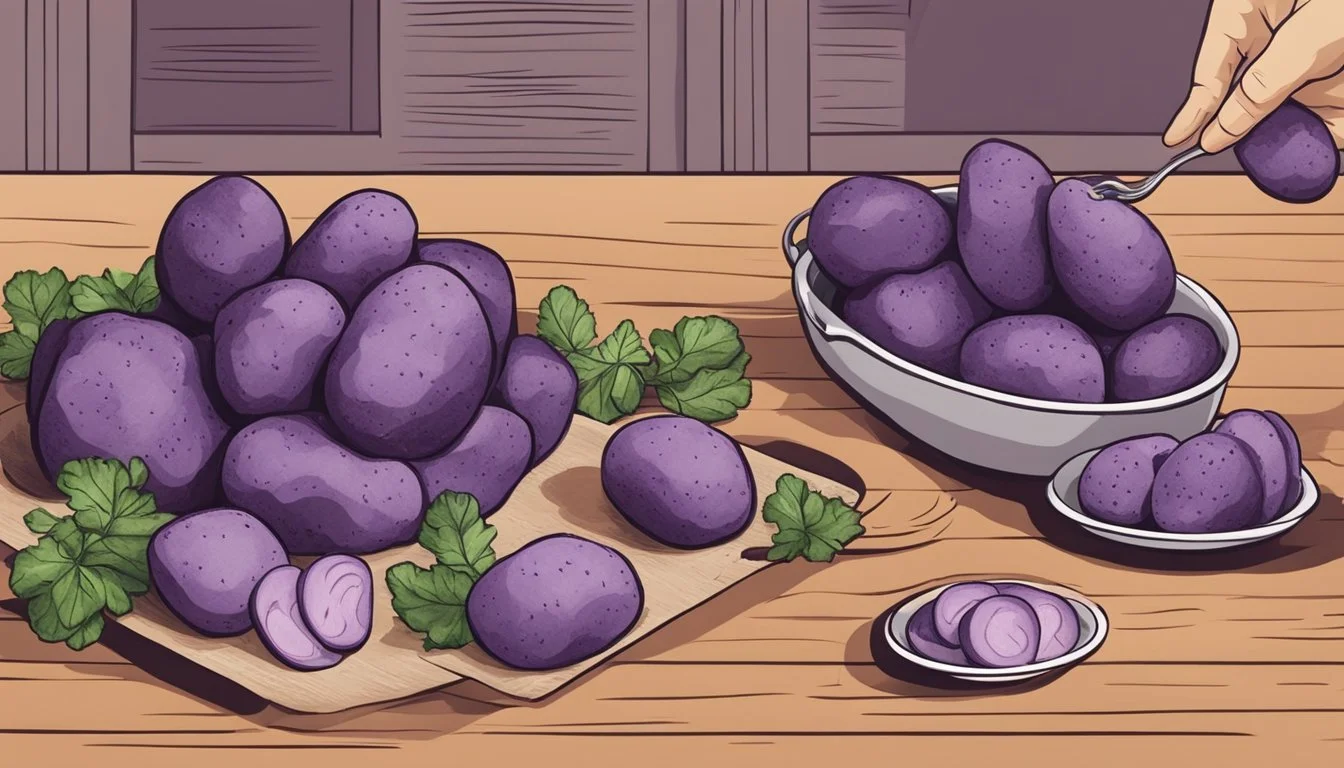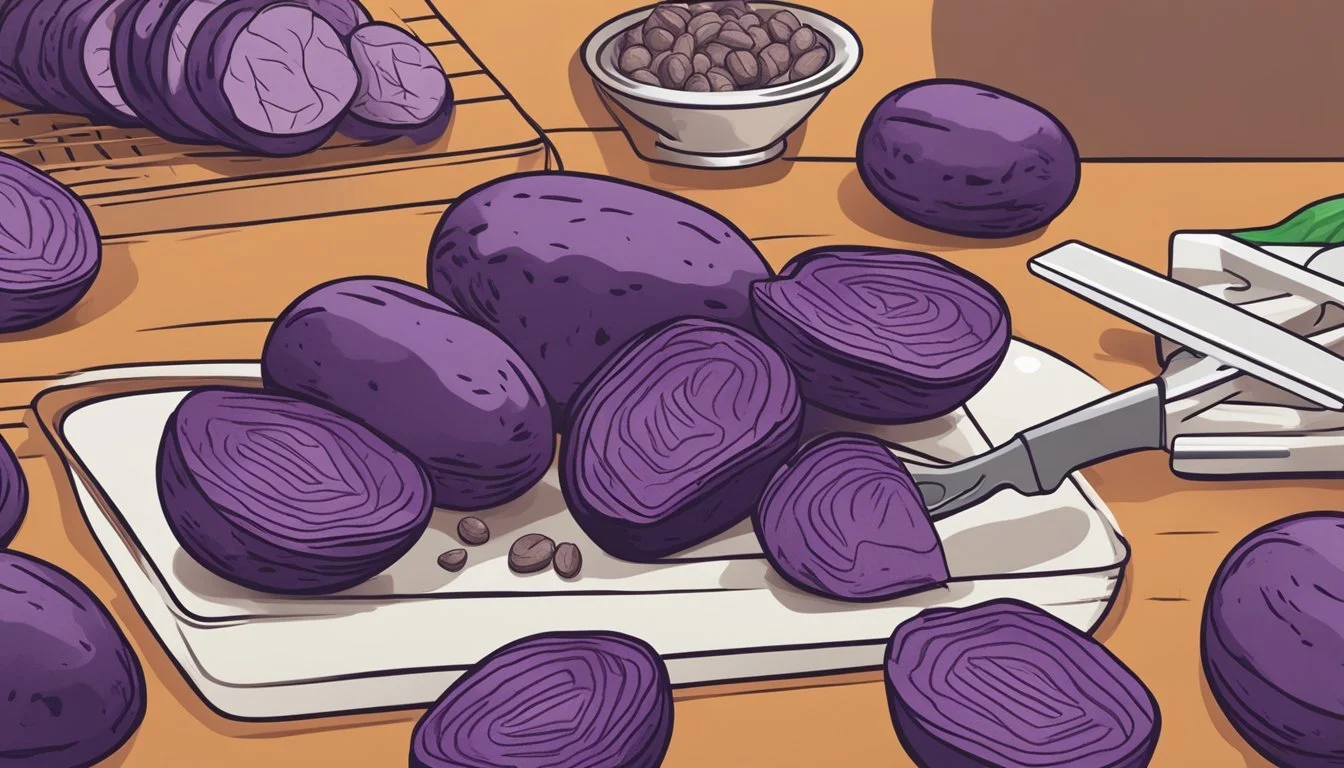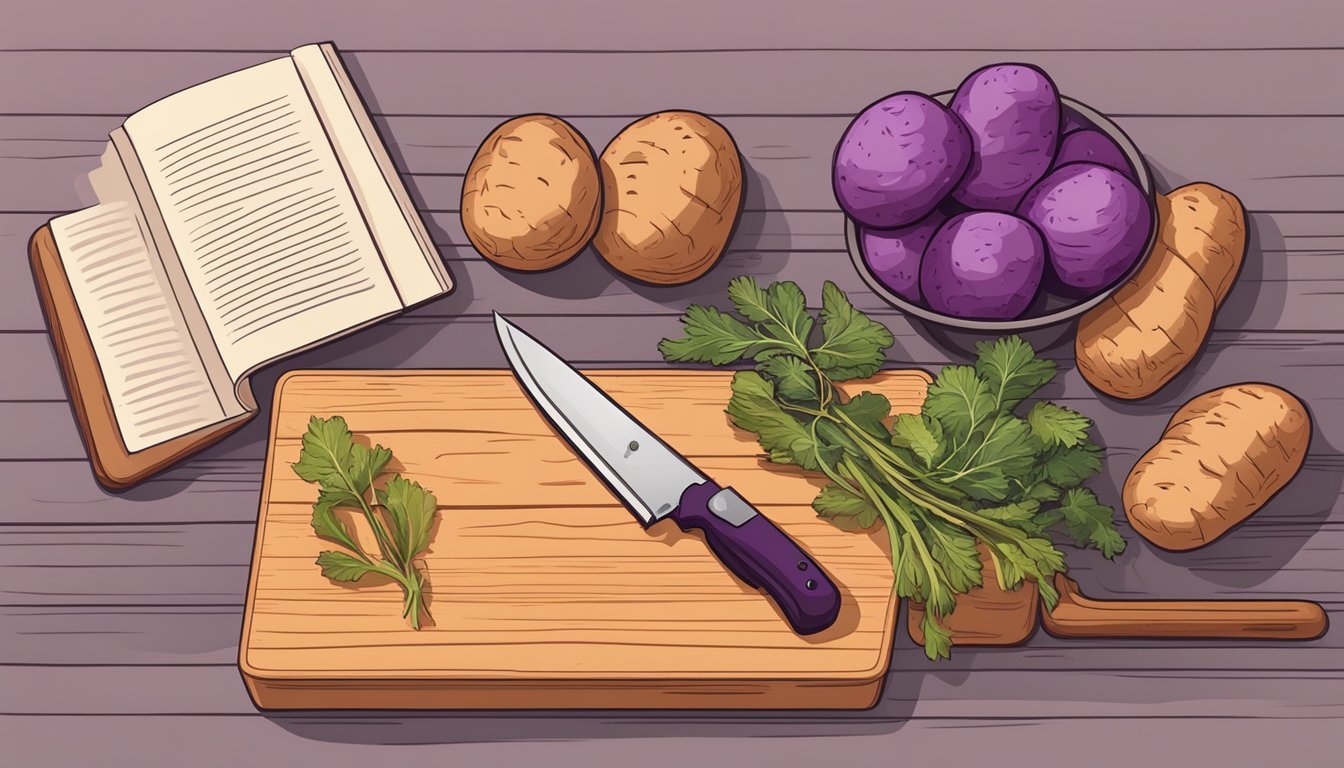How to Substitute Purple Potatoes for Russet Potatoes
A Guide to Swapping Spuds
Substituting purple potatoes for russet potatoes can breathe new life into classic dishes with a touch of color and a nuanced flavor profile. Purple potatoes, known for their vibrant hue and antioxidant content, make an excellent alternative to the starchy russet potatoes commonly used in a variety of recipes. While the textures of these two potato varieties are comparable, purple potatoes tend to have a slightly denser consistency and an earthier, nuttier taste, which can enhance the overall sensory experience of a dish.
When considering a substitute for russet potatoes, it's critical to focus on the desired outcome of the recipe. Purple potatoes hold their shape well when cooked, which makes them suitable for boiling, baking, and roasting, much like their russet counterparts. They are also a natural fit for visually impressive dishes, such as colorful potato salads or vibrant mashed potatoes that can add a visual pop to the plate.
It is important to remember that while the cooking times and methods of preparation largely remain the same when swapping russet for purple potatoes, the latter's unique color can influence the presentation of the final dish. Chefs and home cooks alike should be prepared for the striking hue that purple potatoes can impart, and they may want to pair them with complementary ingredients that highlight their rich, deep color. With a confident approach, purple potatoes can successfully stand in for russet potatoes, turning common recipes into eye-catching and nutritious creations.
Understanding Potato Varieties
When considering substituting purple potatoes for russet potatoes, it's essential to understand the distinct characteristics of each variety, their nutritional profiles, and how these attributes influence their use in culinary applications.
Characteristics of Purple Potatoes
Purple potatoes are notable for their vibrant hue, which comes from anthocyanins, a type of antioxidant. These potatoes tend to be waxy with a moist texture, making them suitable for boiling, steaming, and adding to salads. They often have a smaller, rounder shape and can provide a visually stunning element to dishes.
Color: Deep purple to lavender
Texture: Waxy and moist
Flavor: Earthy, with a slight nuttiness
Best Cooking Methods: Boiling, steaming, roasting
Characteristics of Russet Potatoes
Russet potatoes are a staple in many households known for their thick skin and starchy content, which gives them a light and fluffy texture when cooked. They are ideal for baking, mashing, and frying. Russet potatoes have a classic potato flavor and are typically larger and more oblong than their purple counterparts.
Color: Light to medium brown
Texture: Starchy and fluffy when cooked
Flavor: Mild and earthy
Best Cooking Methods: Baking, mashing, frying
Nutritional Comparisons
Both purple and russet potatoes provide essential nutrients like vitamin C, potassium, and fiber. However, purple potatoes offer additional health benefits due to their higher antioxidant content. Below is a comparison of their nutritional values based on a 100g serving:
Nutrient Purple Potatoes Russet Potatoes Calories 70 79 Carbohydrates 16g 18g Protein 2g 2g Fiber 3g 1.3g Fat 0.1g 0.1g Vitamin C 9.6mg 5.7mg Potassium 400mg 455mg Vitamin B6 0.1mg 0.2mg Iron 0.3mg 0.6mg Vitamin A Not significant Not significant Magnesium 21mg 23mg Glycemic Index Low to Medium Medium to High
Purple potatoes contain a unique and beneficial compound called anthocyanins, which contributes to their rich color and provide antioxidants. While both varieties offer nutrient content, including essential vitamins and minerals, the purple potato's lower glycemic index and high antioxidant and fiber content make them a standout in nutritional value.
Selecting Potatoes for Your Recipe
When substituting purple potatoes for russets, it's essential to consider how the texture and flavor of each potato variety will affect the dish you're preparing.
Texture and Cooking Methods
Purple Potatoes:
Texture: Waxy with low starch content
Cooking methods: Boiling, roasting, steaming
Substituting in recipes requiring potato shape retention
Russet Potatoes:
Texture: Floury with high starch content
Cooking methods: Baking, frying, mashing
More absorbent and tend to lose shape when cooked
For dishes that mandate a fluffy texture, such as mashed potatoes, russets are ideal. However, if a recipe requires the potatoes to maintain their form, such as in salads or stews, purple potatoes are preferable.
Flavor Profiles and Pairings
Purple Potatoes:
Flavor: Earthy and nutty
Suggested pairings: Herbs like rosemary and thyme, robust meats, and leafy greens
Russet Potatoes:
Flavor: Mild and earthy
Frequent use in: Hearty dishes like soups and casseroles that benefit from a neutral base
Purple potatoes bring a vibrant color and a unique flavor that pairs well with bolder ingredients while adding visual appeal to dishes like potato salads and side dishes.
Substituting Potatoes in Cooking
When cooking with potatoes, one must consider the texture and flavor characteristics of different potato varieties. Purple potatoes, like 'Purple Majesty', can successfully replace russet potatoes in various culinary applications, though they often lend a vibrant hue and a slight nuttiness to dishes.
Potato Substitutes in Baking
Baking often calls for fluffy-textured potatoes. Russet potatoes have a high starch content, making them ideal for baking. Purple varieties such as Adirondack Blue or Purple Majesty have similar textures when baked. For baked potatoes:
Purple Peruvian: Holds shape well when baked, good for stuffed baked potatoes.
Purple Majesty: Delivers a moist, hearty result.
In recipes like mashed potatoes, a 1:1 substitution by volume is typically effective. Adding extra butter or cream can help mimic the creaminess of russets.
Potato Substitutes in Savory Dishes
In savory dishes such as soups, stews, and french fries:
Purple potatoes: Maintain their firmness, adding a colorful twist to soups and stews.
Carola potatoes: Their creamy texture makes them a suitable alternative for russets in dishes like soups and stews.
For french fries, purple potatoes can be cut and fried in the same manner as Idaho potatoes but tend to have a denser texture.
When substituting in savory dishes, cooks should note the moisture content and adjust cooking times as needed. For example:
Substitute Dish Note Carola Stews Similar creamy texture as russets. Adirondack Blue French Fries Denser texture; may require less frying time.
Alternative Potatoes in Salads
For potato salads, cooks often favor waxier potatoes, which hold their shape. While russets can become too soft, purple and red potatoes are excellent alternatives for salads:
Red potatoes: They have a waxy texture that is ideal for potato salad.
Inca Gold potatoes: They can substitute for yellow potatoes due to their similar texture and flavor.
A direct substitution by volume or weight works well. However, chefs should consider the salad's aesthetic and whether the purple hue of potatoes like Adirondack Blue complements the other ingredients.
Culinary Techniques for Purple Potatoes
Purple potatoes offer a vibrant twist to traditional potato dishes, with their unique color and texture. To achieve the best results when substituting purple potatoes for russets, one must adapt their cooking techniques due to variations in moisture and starch content.
Tips for Baking and Roasting
Preparation: They should begin by preheating their oven to 400°F (200°C). Washing the skin thoroughly and patting the potatoes dry ensures an even cook. Whether peeling is a matter of preference, as the skin can provide added nutrients and texture.
Baking: When baking, it's essential to pierce the flesh of the potatoes multiple times with a fork to allow steam to escape.
Roasting: For roasting, they can cut the potatoes into 1-inch chunks and toss them with olive oil, garlic, and seasoning before spreading them on a lined baking sheet.
Best Practices for Boiling and Steaming
Boiling: They should start with cold water to ensure even cooking, bringing the water to a boil with the potatoes already in the pot. Adding a pinch of salt enhances flavor.
Steaming: To retain more nutrients, steaming is a preferable method. They can steam the potatoes until just tender, approximately 15-20 minutes, checking for doneness with a fork.
Frying and Grilling Advice
Frying: When frying, choosing a cooking oil with a high smoke point, such as canola oil, is advisable. They should cut the potatoes uniformly to promote even cooking.
Grilling: For grilling, slicing the potatoes into thick, even rounds and brushing them with olive oil prevents sticking and promotes caramelization. Pre-cooking by boiling or steaming can shorten grilling time and ensure a soft interior.
Health Benefits and Considerations
When substituting purple potatoes for russet potatoes, one must consider the nutritional content and the potential impact these variations might have on chronic diseases.
Potato Nutrition and Health
Purple Potatoes:
Fiber: High in fiber, which is beneficial for gut health.
Antioxidants: Contains antioxidants that may help reduce inflammation.
Vitamins: A source of B vitamins and vitamin C.
Minerals: Provides potassium and magnesium.
Russet Potatoes:
Nutrition: Good source of fiber, B vitamins, and resistant starch.
Carbs: Higher in carbs which may impact blood sugar levels.
The substitution of purple potatoes can offer a variety of different health benefits, mainly through their high antioxidant content, which russet potatoes may have less of. The higher levels of antioxidants in purple potatoes contribute to reducing the risk of certain chronic conditions and may aid in managing inflammation.
Impact on Chronic Diseases
Purple Potatoes:
Cardiovascular Health: The potassium and antioxidants may help lower blood pressure, reducing the strain on the cardiovascular system.
Cancer Risk: Antioxidants can help in lowering the risk of certain types of cancer.
Russet Potatoes:
Gut Health: The resistant starch in russet potatoes is beneficial for gut health, potentially lowering the risk of some chronic diseases.
Both purple and russet potatoes offer nutrition that can influence chronic disease outcomes, albeit in slightly different ways. Purple potatoes' impact on chronic diseases leans heavily on the antioxidant capacity, while russet potatoes may offer benefits particularly associated with their resistant starch content.
When using purple potatoes as a substitute for russets, consumers may see a difference in the way these potatoes may influence the management or prevention of chronic diseases, given their distinctive nutritional profiles.
Alternative Potato Substitutions
When seeking to replace Russet potatoes, one can consider various alternatives ranging from low-carb options to nutrient-rich root vegetables. Each substitute offers unique flavors and nutritional benefits while aiming to mimic the texture and culinary uses of Russet potatoes.
Low-Carb Potato Alternatives
Low-carb alternatives are ideal for those looking to reduce carbohydrate intake while still enjoying dishes traditionally made with potatoes.
Turnips: A versatile option, turnips can be mashed or roasted and have a similar texture to potatoes with fewer carbs.
Cauliflower: Often used in a mashed form, cauliflower serves as a low-carb, low-calorie substitute and mimics the creaminess of mashed potatoes.
Jicama: Known for its crispy texture, jicama can be cut into sticks and baked for a healthier version of potato chips or jicama fries.
Radishes: When roasted, radishes become tender and mellow in flavor, making them a suitable low-carb replacement for roasted potatoes.
Zucchini: Though not a root vegetable, zucchini can be sliced and used as a lighter alternative in recipes like zucchini fries.
Root Vegetables as Substitutes
Root vegetables share many attributes with potatoes and can offer a similar mouthfeel and taste profile.
Rutabaga: Rutabagas can be prepared similarly to potatoes and offer a sweeter taste, ideal for mashes or root vegetable medleys.
Parsnips: With their sweet and nutty flavor, parsnips work well as a substitute in baked and mashed forms.
Daikon: This Asian radish has a mild and slightly sweet flavor, suitable for use in stews and soups as a stand-in for potatoes.
Carrots: Roasted or mashed, carrots provide a naturally sweet alternative with a firm texture.
Celery Root (Celeriac): With its potato-like texture, celery root can be used in recipes calling for Idaho potatoes and is excellent in pureed or roasted forms.
Inca Gold Potatoes: While not a low-carb option, these potatoes can replace Russets for those who want a similar but slightly different flavor and texture profile.
These substitutes not only contribute to a well-rounded diet but also add variety and culinary innovation to traditional potato-based recipes.
Seasonal and Regional Considerations
When substituting purple potatoes for russet potatoes, understanding the growing conditions and seasonal availability can inform choices in purchasing and cooking with these tubers.
Growing Conditions and Soil Quality
Purple potatoes and russet potatoes both belong to the species Solanum tuberosum. However, they thrive under slightly different conditions. Russet potatoes, known for their starchy quality and brown skin, prefer a slightly acidic soil pH, typically around 6.0 to 6.5. In contrast, purple potatoes tend to have more vigorous growth in soil that is well-drained with a similar pH range but slightly more fertile. Quality soil enriched with compost or decomposed manure can enhance the concentration of antioxidants, including copper, which is essential for both plant health and human vision and absorption processes.
Availability and Sourcing
Availability of both purple potatoes and russet potatoes can vary based on regional climate and the timing of planting and harvest seasons. Russet potatoes are commonly available year-round in many regions due to their wide cultivation and storage capabilities. Conversely, purple potatoes might be more seasonal, depending on local agricultural conditions.
Russet Potatoes: Consistently sourced year-round.
Purple Potatoes: Availability may fluctuate seasonally.
Local farmers' markets or specialty stores may be the best sources for purple potatoes when they are in season. They are sought for their unique color, and potential health benefits, attributed to their high antioxidant content. Consumers should remain aware that geographic location impacts potato variety presence and thus may need to plan accordingly for substitutions.





